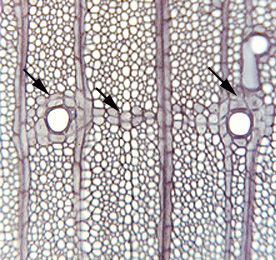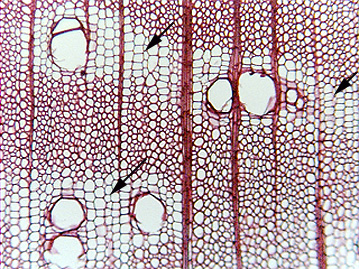 Fig.
15.3-16a and b. Transverse section of wood with banded
paratracheal parenchyma. In both species, the parenchyma forms a
sheath around the vessels, and the sheath of one vessel is confluent with
(touches) the sheath of other vessels. In the upper micrograph (ash, Fraxinus),
the parenchyma is rather sparse, with just a narrow band connecting the
paratracheal parenchyma around the various vessels. But despite being narrow, the
parenchyma cells form a bridge through which water can diffuse relatively freely.
Fig.
15.3-16a and b. Transverse section of wood with banded
paratracheal parenchyma. In both species, the parenchyma forms a
sheath around the vessels, and the sheath of one vessel is confluent with
(touches) the sheath of other vessels. In the upper micrograph (ash, Fraxinus),
the parenchyma is rather sparse, with just a narrow band connecting the
paratracheal parenchyma around the various vessels. But despite being narrow, the
parenchyma cells form a bridge through which water can diffuse relatively freely.
In the lower
micrograph (foxglove tree, Paulownia tomentosa), the parenchyma is
abundant, forming a relatively massive water-rich tissue around the vessels.
Although the micrograph of foxglove tree appears to have two separate masses of
parenchyma, it might be that deeper down in the wood, the two masses of
parenchyma are confluent with each other.